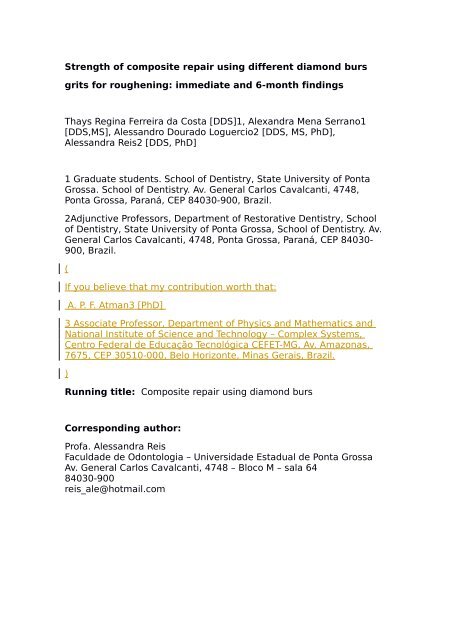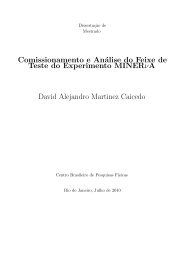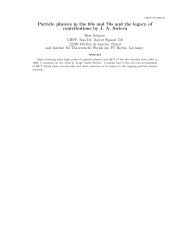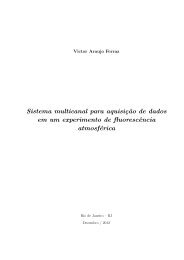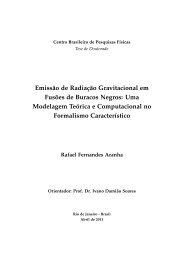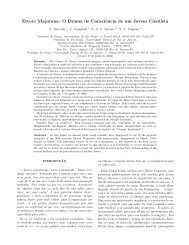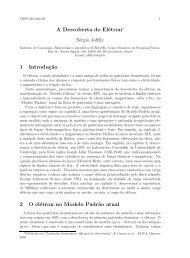Strength of composite repair using different diamond ... - Cbpfindex
Strength of composite repair using different diamond ... - Cbpfindex
Strength of composite repair using different diamond ... - Cbpfindex
You also want an ePaper? Increase the reach of your titles
YUMPU automatically turns print PDFs into web optimized ePapers that Google loves.
<strong>Strength</strong> <strong>of</strong> <strong>composite</strong> <strong>repair</strong> <strong>using</strong> <strong>different</strong> <strong>diamond</strong> burs<br />
grits for roughening: immediate and 6-month findings<br />
Thays Regina Ferreira da Costa [DDS]1, Alexandra Mena Serrano1<br />
[DDS,MS], Alessandro Dourado Loguercio2 [DDS, MS, PhD],<br />
Alessandra Reis2 [DDS, PhD]<br />
1 Graduate students. School <strong>of</strong> Dentistry, State University <strong>of</strong> Ponta<br />
Grossa. School <strong>of</strong> Dentistry. Av. General Carlos Cavalcanti, 4748,<br />
Ponta Grossa, Paraná, CEP 84030-900, Brazil.<br />
2Adjunctive Pr<strong>of</strong>essors, Department <strong>of</strong> Restorative Dentistry, School<br />
<strong>of</strong> Dentistry, State University <strong>of</strong> Ponta Grossa, School <strong>of</strong> Dentistry. Av.<br />
General Carlos Cavalcanti, 4748, Ponta Grossa, Paraná, CEP 84030-<br />
900, Brazil.<br />
(<br />
If you believe that my contribution worth that:<br />
A. P. F. Atman3 [PhD]<br />
3 Associate Pr<strong>of</strong>essor, Department <strong>of</strong> Physics and Mathematics and<br />
National Institute <strong>of</strong> Science and Technology – Complex Systems,<br />
Centro Federal de Educação Tecnológica CEFET-MG, Av. Amazonas,<br />
7675, CEP 30510-000, Belo Horizonte, Minas Gerais, Brazil.<br />
)<br />
Running title: Composite <strong>repair</strong> <strong>using</strong> <strong>diamond</strong> burs<br />
Corresponding author:<br />
Pr<strong>of</strong>a. Alessandra Reis<br />
Faculdade de Odontologia – Universidade Estadual de Ponta Grossa<br />
Av. General Carlos Cavalcanti, 4748 – Bloco M – sala 64<br />
84030-900<br />
reis_ale@hotmail.com
Abstract:<br />
Objective: To evaluate the effects <strong>of</strong> surface treatment and<br />
intermediate agent hydrophilicity on durability <strong>of</strong> the <strong>composite</strong> <strong>repair</strong><br />
by means <strong>of</strong> the <strong>repair</strong> strength, silver nitrate uptake, surface<br />
roughness measurement and scanning electron microscopy analysis<br />
(SEM).<br />
Methods: Fifty <strong>composite</strong> resin blocks with 12 mm <strong>of</strong> diameter and 4<br />
mm high (Opallis, FGM) were polished and, after 7 days, were divided<br />
into 5 groups: no treatment (NT); roughening with a fine-grit (FDB);<br />
medium-grit (MDB); coarse-grit <strong>diamond</strong> burs (CDB) and 50-μm<br />
aluminum oxide sandblasting (AO). A hydrophobic (Adhesive bottle,<br />
Scotchbond Multi-Purpose [SBMP]) or hydrophilic adhesive (Adper<br />
Single Bond 2 [SB]) was then applied. The same <strong>composite</strong> was used<br />
for <strong>repair</strong>. Composite-<strong>composite</strong> bonded sticks (0.9mm2) were tested<br />
immediately [IM] or after 6 months [6M] <strong>of</strong> (submersed?) water<br />
storage in tension (1.0mm/min). Two bonded sticks from each tooth<br />
were immersed in a 50% solution <strong>of</strong> silver nitrate, photo-developed<br />
and analyzed by SEM. Composite specimens after surface treatments<br />
were analyzed with a contact pr<strong>of</strong>ilometer (Ra) and SEM. The data<br />
was statistically analyzed by ANOVA and Tukey´s post hoc tests.<br />
Results: For both adhesives, no significant difference was<br />
detected among the IM and 6M <strong>repair</strong> strength. The AO has showned<br />
the highest <strong>composite</strong> <strong>repair</strong> strength in both adhesives system<br />
(MPa), while the NT group has presentedshowed the lowest. The<br />
<strong>different</strong> <strong>diamond</strong> burs had an intermediate performance in terms <strong>of</strong><br />
<strong>repair</strong> strength. Early signs <strong>of</strong> degradation after 6M were detected by<br />
silver nitrate uptake only for the SB adhesive. The ranking <strong>of</strong> surface
oughness values (Ra) from the lowest to the highest level wasere as<br />
the followings: NT < FDB < MDB < AO ≤ CDB.<br />
Conclusions: The aluminum oxide treatment provides the highest<br />
<strong>composite</strong> <strong>repair</strong> strength, regardless <strong>of</strong> the hydrophilicity <strong>of</strong> the<br />
intermediate agent and storage period. Early signs <strong>of</strong> degradation<br />
were detected for SB after 6 months as silver nitrate deposits within<br />
the adhesive layer.<br />
Clinical Relevance statement:<br />
Keywords:
Introduction<br />
When a <strong>composite</strong> restoration fails as a result <strong>of</strong> discoloration,<br />
microleakage, ditching at the margins, delamination or simply<br />
fracture, the restoration needs to be <strong>repair</strong>ed or replaced (Mjor et al<br />
1993, Denehy et al 1998, Mjor et al 2002, Gordan et al 2006, Ozcan<br />
et al 2006). The total replacement <strong>of</strong> the restoration is the most<br />
common procedure experienced in daily clinical practice (Mjor et al<br />
2002), however, when large portions <strong>of</strong> the restorations are<br />
completely removed, significant loss <strong>of</strong> sound dental tissues occurs<br />
(Krejci et al. 1995; Moscovich et al. 1998; Gordan et al. 2002) because<br />
is <strong>of</strong>ten difficult to remove a tooth-colored adhesive restoration<br />
without removing an integral part <strong>of</strong> the tooth. As a consequence, the<br />
dental structure is weakened and pulp injury may occur. In this<br />
context, <strong>composite</strong> <strong>repair</strong> is considered a minimally invasive protocol<br />
with the additional advantages that it is a low cost less costly<br />
alternative and demands less chair-side time (Mjor et al 1993, Blum et<br />
al 2003).<br />
A previous study had demonstrated that the interfacial bonding<br />
between layers <strong>of</strong> <strong>composite</strong>s decreases as the original layer sets<br />
(Boyer et al 1984), as well as after prolonged water storage (Tezvergil<br />
et al 2003, Brendeke e Ozcan 2007) or others aging methods<br />
(Tezvergil et al 2003, Brendeke e Ozcan 2007, Ozcan et al 2007,<br />
Papacchini et al 2007, Passos et al 2007, Ozcan t al 2010). Thus, in an<br />
attempts to improve the bonding between the existing <strong>composite</strong><br />
restorations and the <strong>repair</strong>ing <strong>composite</strong>, <strong>using</strong> <strong>different</strong> surface<br />
treatments have been suggested. Among them, air abrasion with<br />
aluminum oxide (Swift et al 1992, Turner et al 1993, Swift et al 1994,<br />
Kupiec et al 1996, Brosch et al 1997, Shahdad e Kennedy 1998, Yap et
al 1998, Yap et al 1999, Lucena Martins et al 2001, Oztas et al 2003,<br />
Bonstein et al 2005, Cavalcanti et al 2007, Papacchini et al 2007a,<br />
Papacchini et al. 2007c, Passos et al 2007, Dall’Oca et al 2008, Souza<br />
et al 2008, Rathke et al 2009, Yesilyurtet al. 2009, Costa et al 2010,<br />
Loomans et al 2011(dent mat)), chemical treatments with phosphoric<br />
acid (Lucena Martins et al 2001, Shen et al 2004, Bonstein et al 2005,<br />
Cavalcanti et al 2007, Oscan et al 2007, Papacchini et al 2007a,<br />
Dall’Oca et al 2008, Fawsy et al 2008, Rathke et al 2009, Yesilyurt et<br />
al 2009, Loomans et al 2011, Loomans et al 2011), hydr<strong>of</strong>luoridric<br />
acid (Swift et al 1992, Swift et al 1994, Brosch et al 1997, Lucena<br />
Martins et al 2001, Trajtenberg et al 2004, Passos et al 2007,<br />
Papacchini et al 2007a, Souza et al 2008, Yesilyurt et al 2009,<br />
Loomans et al 2011, Loomans et al 2011), silane application (Swift et<br />
al 1994, Bonstein et al 2005, Brendeke e Ozcan 2007, Oscan et al<br />
2007, Papacchini et al 2007c, Papacchini et al 2007d, Passos et al<br />
2007, Fawsy et al 2008, Rathke et al 2009, Rinastiti et al 2010,) and<br />
surface roughening with <strong>diamond</strong> burs (Bonstein et al 2005,<br />
Cavalcanti et al 2007, Papacchini et al 2007a, Dall’Oca et al 2008,<br />
Rathke et al 2009, Yesilyurt et al 2009, Costa et al 2010, Loomans et<br />
al 2011(dent mat) ) are used to optimize the adherence <strong>of</strong> <strong>repair</strong><br />
material to the existing <strong>composite</strong> restoration. In regard to the latter,<br />
fine (Papacchini et al 2007a, Costa et al 2010), medium ( Dall’Oca et<br />
al 2008, Rathke et al 2009) and coarse (Bonstein et al 2005,<br />
Cavalcanti et al 2007, Yesilyurt et al 2009, Loomans et al 2011 (dent<br />
mat)) <strong>diamond</strong> burs grits have been employed by the authors with no<br />
consensus ion which one is the better alternative.<br />
It is worth mentioning that not only does the surface treatment<br />
plays a role in <strong>composite</strong> <strong>repair</strong> strength. In order to guarantee an
intimate adaptation <strong>of</strong> the <strong>repair</strong> material to polished <strong>composite</strong>, an<br />
intermediate material is required, as the <strong>repair</strong>ing <strong>composite</strong> does not<br />
properly wet the treated resin <strong>composite</strong> (nonsense statement!)<br />
(Boyer et al 1984, Brosch et al 1997, Yap et al 1998, Rathke et al<br />
2009)7,16,26,34. Hydrophilicity <strong>of</strong> the intermediate material for<br />
bonding may impair durability <strong>of</strong> the interfacial bond <strong>repair</strong>, since<br />
more hydrophilic adhesives tend to absorb more water over time<br />
(Malacarne et al 2006)40; however, few attempts have been made to<br />
address this issue (Papacchini et al 2007)11.<br />
Based on that, the aim <strong>of</strong> this study was to evaluate the effects<br />
<strong>of</strong> surface treatment, with <strong>different</strong> <strong>diamond</strong> bur grits and<br />
intermediate materials, on the immediate and long-term and<br />
durability results <strong>of</strong> the <strong>composite</strong> <strong>repair</strong> <strong>of</strong> recently polished<br />
restorations by means <strong>of</strong> the <strong>repair</strong> strength and silver nitrate uptake<br />
(SNU) tests. Additionally, the effects <strong>of</strong> the <strong>different</strong> treatments on the<br />
<strong>composite</strong> roughness and micromorphological features will be<br />
investigated. The null hypothesis investigated is that there is no<br />
difference in terms <strong>of</strong> <strong>composite</strong> <strong>repair</strong> strength, and nanoleakage will<br />
be observed in allbetween the <strong>different</strong> combinations <strong>of</strong> surface<br />
treatment and intermediate material tested.
Materials and Methods<br />
Fifty resin <strong>composite</strong> blocks were made by layering 2 mm thick<br />
increments <strong>of</strong> a microhybrid resin <strong>composite</strong> (Opallis, FGM Dental<br />
Products, Joinville, SC, Brazil, shade A3) in a addition silicone mold (4<br />
mm high and with a diameter <strong>of</strong> 12 mm). Each increment was<br />
condensed with a clean plastic filling instrument to avoid<br />
contamination and light-cured for 40 seconds (VIP, BISCO Inc,<br />
Schaumburg, IL, USA, output: 600 mW/cm2). The last increment was<br />
covered and compressed with a glass microscope slide in order to<br />
obtain a flat surface. Each specimen was removed from the mold and<br />
the surfaces <strong>of</strong> the <strong>composite</strong> blocks were polished with S<strong>of</strong>-Lex Pop<br />
On disks (3M ESPE, St. Paul, MN, USA). Each one <strong>of</strong> the four disks was<br />
used for 10 s in the surface with constant and intermittent pressure<br />
and after then stored in a dark vial with water at 37°C for one week.<br />
The specimens were then randomly divided into 5 groups<br />
according to the kind <strong>of</strong> surface treatment applied: Group NT: no<br />
further treatment was performed in the <strong>composite</strong> surface; Group<br />
DBF: roughening with a fine-grit <strong>diamond</strong> bur for 10 s under water<br />
cooling (#2135F, KG Sorensen, São Paulo, SP, Brazil, 46 μm mean<br />
particle size); Group DBM: roughening with a medium-grit <strong>diamond</strong><br />
bur for 10 s under water cooling (#2135, KG Sorensen, São Paulo, SP,<br />
Brazil, 91 μm mean particle size); Group DBC: roughening with a<br />
coarse-grit <strong>diamond</strong> bur for 10 s under water cooling (#2135G, KG<br />
Sorensen, São Paulo, SP, Brazil, 151 μm mean particle size) Group AO:<br />
the surfaces were sandblasted with 50 μm aluminum oxide powder for<br />
10 seconds at a working distance <strong>of</strong> 5 mm at a pressure <strong>of</strong> 5.5·Pascals<br />
(Pa) with an intraoral sandblaster (Microetcher II, Danville Engineering<br />
Inc, San Ramon, CA, USA).
For A cleaning purposes <strong>of</strong> cleaning, a 35% phosphoric acid<br />
etchant (Scotchbond etchant gel, 3M ESPE, St Paul, MN, USA) was<br />
applied for 30 seconds. After water-rinsing (30 s) and air-drying (10 s),<br />
specimens <strong>of</strong> each group were randomly assigned to two sub-groups<br />
according to the intermediate agents investigated: hydrophobic, non-<br />
solvated bonding group ([SBMP] Adhesive bottle, Adper Scotchbond<br />
Multi Purpose Plus, 3M ESPE, St. Paul, MN, USA) and the hydrophilic<br />
and solvated adhesive group ([SB] Adper Single Bond 2, 3M ESPE, St.<br />
Paul, MN, USA). Both adhesives were rubbed in the <strong>composite</strong><br />
surfaces for 10 s. Solvent evaporation was performed <strong>using</strong> an air-<br />
spray for 10 s at a distance <strong>of</strong> 5 cm, in the groups bonded with Adper<br />
Single Bond 2. The same procedure was performed in the specimens<br />
from SBMP group just for standardization purposes. The adhesive<br />
layer was light-cured for 10 s <strong>using</strong> the same light curing unit for the<br />
<strong>composite</strong> resin blocks. The intermediate agents used in the study,<br />
and their chemical composition are reported in Table 1.<br />
Two 2-mm increments were then placed over the treated<br />
surfaces with the same <strong>composite</strong> resin and they were light-cured<br />
with the same light-curing device for 40 s. Bonded <strong>composite</strong>-<br />
<strong>composite</strong> samples were sectioned with a slow-speed <strong>diamond</strong> saw<br />
(Isomet; Buehler, Lake Bluff, IL, USA) under water cooling in both “x”<br />
and “y” directions across the bonded interface to obtain bonded sticks<br />
with a cross-sectional area <strong>of</strong> approximately 0.9 mm2. The bonded<br />
sticks from each <strong>composite</strong>-<strong>composite</strong> block were then divided to be<br />
tested either immediately [IM] or after 6 months [6M] <strong>of</strong> water<br />
storage at 37°C.<br />
Microtensile testing
The actual cross-sectional area <strong>of</strong> each stick was measured with<br />
the digital caliper to the nearest 0.01 mm and recorded for<br />
subsequent calculation <strong>of</strong> the <strong>repair</strong> bond strength (Absolute<br />
Digimatic, Mitutoyo, Tokyo, Japan). Each bonded stick was attached to<br />
a jig in the universal testing machine (Kratos Dinamometros, São<br />
Paulo, SP, Brazil) with cyanoacrylate resin (Super Bonder gel, Loctite,<br />
São Paulo, SP, Brazil) and subjected to a tensile force at 1.0 mm/min.<br />
The failure modes were evaluated at 400X (HMV-2, Shimadzu, Tokyo,<br />
Japan) and classified as cohesive (failure exclusively within the<br />
<strong>composite</strong>, - C), or adhesive (failure at <strong>composite</strong>-<strong>composite</strong> interface<br />
– A), or adhesive/mixed (failure at <strong>composite</strong>-<strong>composite</strong> interface that<br />
included cohesive failure <strong>of</strong> the neighboring <strong>composite</strong>,- A/M).<br />
After analyzing the microtensile bond strength data for<br />
normalizationty (?) <strong>of</strong> data distribution (Kolmogorov–Smirnov test) and<br />
homogeneity <strong>of</strong> variances (Levene’s test), a two-way repeated<br />
measures analysis <strong>of</strong> variance (ANOVA) was applied for each adhesive<br />
system, considering with the <strong>composite</strong> <strong>repair</strong> strength as the<br />
dependent variable and surface treatment and storage time (IM vs.<br />
6M) as the independent factors. The storage period was considered<br />
the repeated measure (???). The Tukey’s test was used for post-hoc<br />
comparisons at a significance level <strong>of</strong> 0.05.<br />
Silver Nitrate uptake (SNU)<br />
Two bonded sticks from each <strong>composite</strong> block at each storage<br />
period were not tested in tension but coated with two layers <strong>of</strong> nail<br />
varnish applied up to within 1 mm <strong>of</strong> the bonded interfaces. The<br />
specimens were re-hydrated in distilled water for 10 min prior to<br />
immersion in an aqueous solution <strong>of</strong> 50%wt <strong>of</strong> silver nitrate for 24 h.<br />
Conventional silver nitrate was prepared according to the protocol
previously described by Tay et al 2002. The sticks were placed in the<br />
conventional silver nitrate in darkness for 24 h, rinsed thoroughly in<br />
distilled water and immersed in a photo-developing solution for 8 h<br />
under a fluorescent light to reduce silver ions into metallic silver<br />
grains within voids along the bonded interface.<br />
Specimens were wet polished <strong>using</strong> SiC paper with decreasing<br />
grit (1000, 1200, 1500, 2000, 2400) and 1 and 1/4 µm <strong>diamond</strong> paste<br />
(Buehler Ltd, Lake Bluff, IL, USA) <strong>using</strong> a polish cloth. They were<br />
ultrasonically cleaned, air dried, mounted on aluminum stubs and<br />
sputtered with carbon (MED 010, Balzers Union, Balzers,<br />
Liechtenstein). Composite-<strong>composite</strong> interfaces were analyzed in a<br />
scanning electron microscope (JSM 6060, JEOL, Tokyo, Japan) operated<br />
in the backscattered electron model. The working distance was 8 mm<br />
and the accelerating voltage was 20 KV.<br />
Three pictures were taken <strong>of</strong> each specimen and they were all<br />
taken by a technician who was blinded to the experimental conditions<br />
under evaluation. The images were only qualitatively and<br />
quantitatively analyzed.<br />
Surface roughness measurement<br />
Thirty resin <strong>composite</strong> blocks were made by a microhybrid resin<br />
<strong>composite</strong> (Opallis, FGM Dental Products, Joinville, SC, Brazil, shade<br />
A3) in an addition silicone mold (3 mm high and with a diameter <strong>of</strong> 7<br />
mm). Each increment (± 1mm thickness) was condensed with a clean<br />
plastic filling instrument to avoid contamination and light-cured for 40<br />
seconds (VIP, BISCO Inc, Schaumburg, IL, USA, output: 600 mW/cm2).<br />
The last increment was covered and compressed with a glass<br />
microscope slide in order to obtain a flat surface. . Each specimen was<br />
removed from the mold and the surfaces <strong>of</strong> the <strong>composite</strong> blocks
were polished with S<strong>of</strong>-Lex Pop On disks (3M ESPE, St. Paul, MN, USA).<br />
Each one <strong>of</strong> the four disks was used for 10 s in the surface with<br />
constant and intermittent pressure and after then stored in a dark vial<br />
with water at 37°C for one week.<br />
The specimens were then divided to each the <strong>different</strong> surface<br />
treatment groups and treated as mentioned (n= 6 per group). Surface<br />
roughness test was performed with a contact pr<strong>of</strong>ilometer (Mitutoyo<br />
Surftest 301, Mitutoyo, Tokyo, Japan). Five successive measurements<br />
in <strong>different</strong> directions were recorded for all specimens in each group,<br />
and the average surface roughness (Ra) value there<strong>of</strong> obtained. The<br />
cut-<strong>of</strong>f value for surface roughness was 0.25 mm, and the sampling<br />
length for each measurement was 1.25 mm. Data were analyzed<br />
<strong>using</strong> one-way ANOVA and Tukey’s test at a significance level <strong>of</strong> 0.05.<br />
Scanning electron microscopy analysis<br />
The same specimens used in the roughness test were prepared<br />
for scanning electron microscopy (JSM 6400, JEOL, Tokyo, Japan)<br />
analysis. Specimens were sputter-coated with gold to a thickness <strong>of</strong><br />
approximately 200Å in a vacuum evaporator. Photographs <strong>of</strong><br />
representative areas <strong>of</strong> the polished and treated surfaces were taken<br />
at ×1200 magnification. The images were treated <strong>using</strong> Image J®<br />
s<strong>of</strong>tware to extract the gray level Z for each pixel located at position<br />
(X,Y), and exported as (X,Y,Z) pr<strong>of</strong>iles which were analyzed <strong>using</strong> the<br />
s<strong>of</strong>tware Qtiplot® in order to calculate the total roughness and<br />
estimate the total surface area. The roughness in gray level is<br />
compared to the (Ra, Rs, Rt) experimental values in order to calibrate<br />
the gray level in milimeters. Due the self-similar features observed in<br />
the AO specimen, a technique based on fractal geometry was applied<br />
to estimate the actual surface area with more accuracy. The results
for the global roughness and estimated surface area <strong>of</strong> the samples<br />
are shown in Table 4. In Figure 4 the three stages <strong>of</strong> the image<br />
treatment are exemplified for a DBC sample. The sketch <strong>of</strong> the<br />
technique used to estimate the surface area is also shown.
Resultss<br />
Microtensile Testing<br />
Mean values and standard deviations (MPa) <strong>of</strong> <strong>composite</strong> <strong>repair</strong><br />
strength for each adhesive are shown in Table 2. The two-way<br />
repeated measures analysis <strong>of</strong> variance (ANOVA) for SBMP showed<br />
that onlyjust the surface treatment wais significant (p
Surface Roughness Test and SEM Analysis<br />
Means and standard deviations (µm) <strong>of</strong> the roughening<br />
produced by the <strong>different</strong> surface treatments are shown in Table 3.<br />
One-way ANOVA showed that surface roughness wais statistically<br />
significant (p
Discussion<br />
The results <strong>of</strong> this study indicate showed that any kind <strong>of</strong><br />
roughening produced either by aluminum oxide and or <strong>diamond</strong> bur<br />
can increase the <strong>repair</strong> bond strength, when compared to the control<br />
group with no treatment. T and this finding is in agreement with other<br />
studies (Turner et al 1993, Kupiec et al 1996, Brosch et al 1997,<br />
Shahdad et al 1998, Lucena-Martín et al 2001, Oztas et al 2003,<br />
Papacchini et al 2007, Souza et al 2008, Costa et al 2010). This has an<br />
important clinical implication. If <strong>repair</strong> is to be performed on a<br />
recently polished <strong>composite</strong> surface, clinicians should attempt to<br />
increase the surface area prior to the procedure.<br />
However, the present investigation demonstrated that<br />
variations in the <strong>diamond</strong> bur grits did not affect the <strong>repair</strong> bond<br />
strength. Although the coarse burs produced higher roughness than<br />
did the fine and medium burs, the pattern <strong>of</strong> micro-retentions<br />
produced by the burs were quite similar. Ermis et al, (2008)<br />
investigating the effect <strong>of</strong> <strong>different</strong> burs on the bond strength <strong>of</strong> self-<br />
etch adhesives to dentin also reached similar conclusions, i.e., the<br />
<strong>diamond</strong> bur grits did not seem to have an important effect on<br />
adhesion to dentin.<br />
Microretentive interlocking has been reported to be the most<br />
important factor for establishing a bond between old and <strong>repair</strong><br />
<strong>composite</strong>s and most likely dominates chemical bonds to the resin<br />
matrix or to exposed filler particles (Brosch et al 1997, Shahdad et al<br />
1998). In fact, it is confirmed by the lack <strong>of</strong> improvements in terms <strong>of</strong><br />
<strong>repair</strong> strength when silane is applied to aged <strong>composite</strong>, with the aim<br />
to improve chemical bond with the <strong>repair</strong> <strong>composite</strong> (Matinlinna et al
2004, Bonstein et al 2005), is a further evidence that<br />
micromechanical interlocking may be the main bonding mechanism<br />
underlying <strong>composite</strong> <strong>repair</strong>.<br />
However, it is worth mentioning that the increase in roughness<br />
does not necessary means increasinged surface area for adhesion. If<br />
we compare the roughness produced by the aluminum oxide and<br />
coarse <strong>diamond</strong> bur one can note that they are similar, but the<br />
resulting roughness pattern produced by these two procedures are<br />
quite <strong>different</strong> under SEM evaluation. A more regular pattern <strong>of</strong><br />
roughness was produced by the coarse <strong>diamond</strong> bur with<br />
unidirectional peaks and valleys, while a more three-dimensional<br />
roughness was produced by the aluminum oxide sandblasting with<br />
variations in the peaks and valleys heights and self-similar features.<br />
SEM images <strong>of</strong> earlier studies (Lucena-Martín et al 2001, Bonstein et<br />
al 2005, Papacchini et al 2007, Dall’oca et al 2008, Rathke et al 2009,<br />
Yesilyurt et al 2009, Costa et al 2010)11,14,15,18,22,26,32 agree with<br />
the present investigation, demonstrating that aluminum oxide<br />
sandblasting is able to produce more micro-retentive features. The<br />
image treatment indicates One may speculate that the available area<br />
for adhesion area produced by aluminum oxide isseems to be much<br />
higher than that produced by the coarse <strong>diamond</strong> bur, despite the<br />
similar Ra roughness produced by both clinical approaches. Besides<br />
that, one cannot rule out the fact that a smear layer is produced when<br />
the <strong>composite</strong> is roughened with a <strong>diamond</strong> bur, finding not observed<br />
in the aluminum oxide-treated surfaces (???). Whether this has an<br />
important effect on the differences observed is yet to be investigated.<br />
Previous studies demonstrated that the use <strong>of</strong> an adhesive after<br />
mechanical roughening has a significant effect on the <strong>repair</strong> bond
strength (Shahdad et al 1998, Lucena-Martín et al 2001, Tezvergil et al<br />
2003, Oztas et al 2003) and this may be attributed to the adhesives<br />
seeping into and leveling <strong>of</strong>f the micro-relief produced by mechanical<br />
roughening. But there is a lack <strong>of</strong> information in literature lacks<br />
information about concerning the influence <strong>of</strong> hydrophilicity <strong>of</strong> the<br />
intermediate agent on the durability <strong>of</strong> the <strong>composite</strong> <strong>repair</strong>. The<br />
results <strong>of</strong> the current study is in agreement with an earlier study<br />
(Costa et al 2010)14 that demonstrated that hydrophilicity <strong>of</strong> the<br />
intermediate agent did not affect the immediate and 6-month<br />
<strong>composite</strong> <strong>repair</strong> strength.<br />
However, spotted silver nitrate deposits were seen in specimens<br />
bonded with the solvated, hydrophilic system (SB) after six months <strong>of</strong><br />
water storage. Probably, tThis likely resulted from the increased water<br />
sorption and solubility <strong>of</strong> the hydrophilic adhesive layer (Malacarne et<br />
al 2006, Malacarne-Zanon 2009). Although this finding did not result<br />
in any reduction in <strong>composite</strong> <strong>repair</strong> strength, it represents early signs<br />
<strong>of</strong> degradation. This may lead to marginal discoloration <strong>of</strong> the<br />
<strong>repair</strong>ed interface over time and eventually interfacial debonding over<br />
the long run. Perhaps if the evaluation <strong>of</strong> such the <strong>composite</strong> <strong>repair</strong><br />
wasere done under after more prolonged periods <strong>of</strong> time, reductions<br />
in the <strong>repair</strong> strength with SB could have been detected. The<br />
specimens were only stored for six months, because this is the<br />
storage period mostly used by researchers to study degradation <strong>of</strong><br />
resin dentin bonds (Gwinnett et al 1995, Stanislawczuk et al 2009,<br />
Reis et al 2010)41-43.<br />
The extent to which the results <strong>of</strong> the current investigation may<br />
be extrapolated for the clinical scenario and how it may affect clinical<br />
longevity <strong>of</strong> a clinical <strong>repair</strong> are issues is yet to be addressed.
Conclusions<br />
The aluminum oxide treatment provides the highest <strong>composite</strong><br />
<strong>repair</strong> strength, regardless <strong>of</strong> the hydrophilicity <strong>of</strong> the intermediate<br />
agent and storage period. Have nNo significant difference in the<br />
adhesion was observed amongbetween the <strong>diamond</strong>s groups. Early<br />
signs <strong>of</strong> degradation were detected for SB after 6 months as silver<br />
nitrate deposits within the adhesive layer.
Acknowledgments<br />
This study was partially supported by the National Council for<br />
Scientific and Technological Development (CNPq) under grants<br />
305075/2006-3 and 303933/2007-0. The authors would like to thank<br />
FGM Dental Products and Erios for the donation <strong>of</strong> some materials<br />
employed in this study.
References<br />
1. Mjor IA. Repair versus replacement<strong>of</strong> failed restorations. Int<br />
Dent J 1993;43:466-472.<br />
2. Denehy G, Bouschlicher M, Vargas M. Intraoral <strong>repair</strong> <strong>of</strong><br />
cosmetic restorations. Dent Clin North Am 1998;42:719-737.<br />
3. Mjor IA, Gordan VV. Failure, <strong>repair</strong>, refurbishing and longevity <strong>of</strong><br />
restorations. Oper Dent 2002;27:528-534.<br />
4. Gordan VV, Shen C, Riley J 3rd, Mjor IA. Two-year clinical<br />
evaluation <strong>of</strong> <strong>repair</strong> versus replacement <strong>of</strong> <strong>composite</strong><br />
restorations. J Esthet and Restor Dent 2006;18:144-154.<br />
5. Ozcan M. Longevity <strong>of</strong> <strong>repair</strong>ed <strong>composite</strong> and metal-ceramic<br />
restorations: 3.5 year clinical study [abstract 0076]. J Dent Res<br />
2006; (special issue B):85.<br />
6. Krejci I, Lieber CM, Lutz F. Time required to remove totally<br />
bonded tooth-colored posterior restorations and related tooth<br />
substance loss. Dent Mater 1995 Jan;11(1):34-40.<br />
7. Moscovich H, Creugers NH, De Kanter RJ, Roeters FJ. Loss <strong>of</strong><br />
sound tooth structure when replacing amalgam restorations by<br />
adhesive inlays. Oper Dent 1998 Nov-Dec;23(6):327-31.<br />
8. Gordan VV, Mondragon E, Shen C. Replacement <strong>of</strong> resin-based<br />
<strong>composite</strong>: evaluation <strong>of</strong> cavity design, cavity depth, and shade<br />
matching. Quintessence Int 2002 Apr;33(4):273-8.<br />
9. Blum IR, Schriever A, Heidemann D, et al. The <strong>repair</strong> <strong>of</strong> direct<br />
<strong>composite</strong> restorations: an international survey <strong>of</strong> the teaching<br />
<strong>of</strong> operative techniques and materials. Eur J Dent Educ<br />
2003;7:41–8.<br />
10.Boyer DB, Chan KC & Reinhardt JW. Build-up and <strong>repair</strong> <strong>of</strong> light-<br />
cured <strong>composite</strong>s: Bond strength. J Dent Res 1984;63(10):1241-<br />
1244.
11.Tezvergil A, Lassila LVJ, Vallittu PK. Composite–<strong>composite</strong> <strong>repair</strong><br />
bond strength: effect <strong>of</strong> <strong>different</strong> adhesion primers. J Dent 2003;<br />
31:521–525.<br />
12.Brendeke J, Ozcan M. Effect <strong>of</strong> physicochemical aging conditions<br />
on the <strong>composite</strong>-<strong>composite</strong> <strong>repair</strong> bond strength. J Adhes Dent<br />
2007; 9(4):399-406.<br />
13.Ozcan M, Barbosa SH, Melo RM, Galhano GA & Bottino MA.<br />
Effect <strong>of</strong> surface conditioning methods on the microtensile bond<br />
strength <strong>of</strong> resin <strong>composite</strong> to <strong>composite</strong> after aging conditions.<br />
Dent Mat 2007;23(10):1276-1282.<br />
14.Papacchini F, Toledano M, Monticelli F, Osorio R, Radovic I,<br />
Polimeni A, García-Godoy F, Ferrari M. Hydrolytic stability <strong>of</strong><br />
<strong>composite</strong> <strong>repair</strong> bond. Eur J Oral Sci 2007;115:417–424.<br />
15.Passos SP, Ozcan M, Vanderlei AD, Leite FPP, Kimpara ET,<br />
Bottino MA. Bond strength durability <strong>of</strong> direct and indirect<br />
<strong>composite</strong> systems following surface conditioning for <strong>repair</strong>. J<br />
Adhes Dent 2007; 9 (5): 443-447.<br />
16.Ozcan M, Curab C, Brendekec J. Effect <strong>of</strong> Aging Conditions on<br />
the Repair Bond <strong>Strength</strong> <strong>of</strong> a Microhybrid and a Nanohybrid<br />
Resin Composite. J Adhes Dent 2010; 12:451-459.<br />
17.Swift Jr EJ, LeValley BD, Boyer DB. Evaluation <strong>of</strong> new methods<br />
for <strong>composite</strong> <strong>repair</strong>. Dent Mater 1992;8:362-365.<br />
18.Turner CW & Meiers JC. Repair <strong>of</strong> an aged, contaminated indirect<br />
<strong>composite</strong> resin with a direct, visible-lightcured <strong>composite</strong> resin.<br />
Oper Dent 1993;18(5):187-194.<br />
19.Swift Jr EJ, Cloe BC, Boyer DB. Effect <strong>of</strong> a silane coupling agent<br />
on <strong>composite</strong> <strong>repair</strong>s strengths. Am J Dent 1994; 7(4):200-204.<br />
20.Kupiec KA & Barkmeier WW. Laboratory evaluation <strong>of</strong> surface<br />
treatments for <strong>composite</strong> <strong>repair</strong> Oper Dent 1996; 21(2):59-62.
21.Brosch T, Pilo R, Bichacho N & Blutstein R. Effect <strong>of</strong><br />
combinations <strong>of</strong> surface treatments and bonding agents on the<br />
bond strength <strong>of</strong> <strong>repair</strong>ed <strong>composite</strong>s. J Prosth<br />
Dent1997;77(2):122-126.<br />
22.Shahdad SA & Kennedy JG. Bond strength <strong>of</strong> <strong>repair</strong>ed anterior<br />
<strong>composite</strong> resins: An in vitro study. J Dent 1998;26(8):685-694.<br />
23.Yap AU, Quek CE & Kau CH. Repair <strong>of</strong> new-generation tooth-<br />
colored restoratives: Methods <strong>of</strong> surface conditioning to achieve<br />
bonding. Oper Dent 1998;23(4):173-178.<br />
24.Yap AU, Sau CW & Lye KW. Effects <strong>of</strong> aging on <strong>repair</strong> bond<br />
strengths <strong>of</strong> a polyacid-modified <strong>composite</strong> resin. Oper<br />
Dent1999;24(6):371-376.<br />
25.Lucena-Martín C, González-López S & Navajas-Rodríguez de<br />
Mondelo JM. The effect <strong>of</strong> various surface treatments and<br />
bonding agents on the <strong>repair</strong>ed strength <strong>of</strong> heat-treated<br />
<strong>composite</strong>s. J Prosth Dent 2001;86(5):481-488.<br />
26.Oztas N, Alaçam A & Bardakçy Y. The effect <strong>of</strong> air abrasion with<br />
two new bonding agents on <strong>composite</strong> <strong>repair</strong>. Oper Dent<br />
2003;28(2):149-154.<br />
27.Bonstein T, Garlapo D, Donarummo J Jr & Bush PJ. Evaluation <strong>of</strong><br />
varied <strong>repair</strong> protocols applied to aged <strong>composite</strong> resin. J Adhe<br />
Dent 2005;7(1):41-49.<br />
28.Cavalcanti AN, De Lima AF, Peris AR, Mitsui FH & Marchi GM.<br />
Effect <strong>of</strong> surface treatments and bonding agents on the bond<br />
strength <strong>of</strong> <strong>repair</strong>ed <strong>composite</strong>s. J Esth and Rest Dent<br />
2007;19(2):90-99.<br />
29.Papacchini F, Dall’Oca S, Chieffi N, Goracci C, Sadek FT, Suh BI,<br />
Tay FR & Ferrari M. Composite-to-<strong>composite</strong> microtensile bond<br />
strength in the <strong>repair</strong> <strong>of</strong> a micr<strong>of</strong>illed hybrid resin: Effect <strong>of</strong>
surface treatment and oxygen inhibition. J Adhe Dent<br />
2007;9(1):25-31.<br />
30.Papacchini F, Monticelli F, Radovic I, Chieffi N, Goracci C, Tay FR,<br />
Polimeni A & Ferrari M. The application <strong>of</strong> hydrogen peroxide in<br />
<strong>composite</strong> <strong>repair</strong> J Biom Mat Res Part B Applied Biomaterials<br />
2007;82(2):298-304.<br />
31.Dall’oca S, Papacchini F, Radovic I, Polimeni A & Ferrari M.<br />
Repair potential <strong>of</strong> a laboratory-processed nano-hybrid resin<br />
<strong>composite</strong>. J <strong>of</strong> Oral Sciences 2008;50(4):403-412.<br />
32.Souza EM, Francischone CE, Powers JM, Rached RN & Vieira S.<br />
Effect <strong>of</strong> <strong>different</strong> surface treatments on the <strong>repair</strong> bond<br />
strength <strong>of</strong> indirect <strong>composite</strong>s. Am J Dent 2008;21(2):93-96.<br />
33.Rathke A, Tymina Y & Haller B. Effect <strong>of</strong> <strong>different</strong> surface<br />
treatments on the <strong>composite</strong>-<strong>composite</strong> <strong>repair</strong> bond strength.<br />
Clin Oral Invest 2009;13(3): 317-323.<br />
34.Yesilyurt C, Kusgoz A, Bayram M, Ulker M. Initial Repair Bond<br />
<strong>Strength</strong> <strong>of</strong> a Nano-filled Hybrid Resin: Effect <strong>of</strong> Surface<br />
Treatments and Bonding Agents. J Esthet Restor Dent<br />
2009;21(4):251–261.<br />
35.Costa TR, Ferreira SQ, Klein-Júnior CA, Loguercio AD, Reis A.<br />
Durability <strong>of</strong> surface treatments and intermediate agents used<br />
for <strong>repair</strong> <strong>of</strong> a polished <strong>composite</strong>. Oper Dent 2010 Mar-<br />
Apr;35(2):231-7.<br />
36.Loomans BAC, Cardoso MV, Roeters FJM, Opdam NJM, DeMunck<br />
J, Huysmans MCDNJM, VanMeerbeek B. Is there one optimal<br />
<strong>repair</strong> technique for all <strong>composite</strong>s? Dent Mat 2011; Article in<br />
press.
37.Shen C, Mondragon E, Gordan VV, Mjör IA. The effect <strong>of</strong><br />
mechanical undercuts on the strength <strong>of</strong> <strong>composite</strong> <strong>repair</strong>. J Am<br />
Dent Assoc. 2004 Oct;135(10):1406-12.<br />
38.Fawzy AS, El-Askary FS & Amer MA. Effect <strong>of</strong> surface treatments<br />
on the tensile bond strength <strong>of</strong> <strong>repair</strong>ed wateraged anterior<br />
restorative micro-fine hybrid resin <strong>composite</strong>. J Dent<br />
2008;36(12):969-976.<br />
39.Loomans BAC, Cardoso MV, Opdam NJM, Roeters FJM, DeMunck<br />
J, Huysmans MCDNJM, VanMeerbeek B. Surface roughness <strong>of</strong><br />
etched <strong>composite</strong> resin in light <strong>of</strong> <strong>composite</strong> <strong>repair</strong>. J Dent 2011;<br />
Article in press.<br />
40.Trajtenberg CP, Powers JM. Effect <strong>of</strong> hydr<strong>of</strong>luoric acid on <strong>repair</strong><br />
bond strength <strong>of</strong> a laboratory <strong>composite</strong>. Am J Dent<br />
2004;17(3):173-176.<br />
41.Rinastiti M, Özcan M, Siswomihardjo W, Busscher HJ, Van Der<br />
Mei HC. Effect <strong>of</strong> Bi<strong>of</strong>ilm on the Repair Bond <strong>Strength</strong>s <strong>of</strong><br />
Composites. J Dent Res 2010;89(12):1476-1481.<br />
42.Malacarne J, Carvalho RM, de Goes MF, Svizero N, Pashley DH,<br />
Tay FR, Yiu CK & Carrilho MR. Water sorption/solubility <strong>of</strong> dental<br />
adhesive resins. Dent Mat 2006;22(10):973-980.<br />
43.Tay FR, Pashley DH & Yoshiyama M. Two modes <strong>of</strong> nanoleakage<br />
expression in single-step adhesives. J Dent Rese<br />
2002;81(7):472-476.<br />
44.Ermis RB, Muncka JD, Cardoso MV, Coutinho E, Landuyt KLV,<br />
Poitevin A, Lambrechts P, Van Meerbeek B. Bond strength <strong>of</strong><br />
self-etch adhesives to dentin prepared with three <strong>different</strong><br />
<strong>diamond</strong> burs. Dent Mat 2008;2(4):978–985.
45.Matinlinna JP, Lassila LV, Ozcan M, Yli-Urpo A, Vallittu PK. An<br />
introduction to silanes and their applications in dentistry. Int J<br />
Prosthodont 2004; 17:155-164.<br />
46.Malacarne-Zanon J, Pashley DH, Agee KA, Foulger S, Alves MC,<br />
Breschi L, Cadenaro M, Garcia FP, Carrilho MR. Effects <strong>of</strong> ethanol<br />
addition on the water sorption/solubility and percent conversion<br />
<strong>of</strong> comonomers in model dental adhesives. Dent Mat 2009; 2<br />
5:1275–1284<br />
47.Gwinnett AJ & Yu S. Effect <strong>of</strong> long-term water storage on dentin<br />
bonding Am J Dent 1995;8(2):109-111.<br />
48.Stanislawczuk R, Amaral RC, Zander-Grande C, Gagler D, Reis A<br />
& Loguercio AD. Chlorhexidine-containing acid conditioner<br />
preserves the longevity <strong>of</strong> resin-dentin bonds. Oper Dent<br />
2009;34(4):481-490.<br />
49.Reis A, Sabrina QF, Costa TRF, Klein-Júnior CA, Meier MM,<br />
Loguercio AD. Effects <strong>of</strong> increased exposure times <strong>of</strong> simplified<br />
etch-and-rinse adhesives on the degradation <strong>of</strong> resin–dentin<br />
bonds and quality <strong>of</strong> the polymer network Eur J Oral Sci 2010;<br />
118: 502–509.<br />
Table 1 – Composition <strong>of</strong> the materials employed in this study.<br />
Material Composition<br />
Opallis <strong>composite</strong> (FGM Dental<br />
Products)<br />
Bis-GMA monomers, Bis-EMA,<br />
TEGDMA, UDMA, camphorquinone,<br />
co-initiator, silanized bariumaluminum<br />
silicate glass (particle<br />
size <strong>of</strong> 0.5 μm, 79.8 wt%), pigments<br />
and silica.<br />
Adper Single Bond 2 (3M ESPE) Bis-GMA, HEMA, dimethacrylates,<br />
ethanol, water, a novel<br />
photoinitiator system and a<br />
methacrylate functional copolymer<br />
<strong>of</strong> polyacrylic and polyitaconic<br />
acids, silica nan<strong>of</strong>iller (5nm<br />
diameter silica particles, 10 wt%)
Adhesive, Adper Scotchbond<br />
Multi Purpose Plus (3M ESPE)<br />
Adhesive bottle: Bis-GMA, HEMA<br />
and initiators<br />
Abbreviations: Bis-GMA: bis-phenol A di-Glycidyl Methacrylate; Bis-EMA: bis-phenol<br />
A di-Glycidyl Methacrylate ethoxylated; TEGDMA: Triethylene Glycol<br />
Ddimethacrylate, UDMA: Urethane Dimethacrylate; HEMA: Hydroxyethyl<br />
Metacrylate.
Table 2 – Means and standard deviations (MPa) <strong>of</strong> <strong>composite</strong> <strong>repair</strong><br />
strength for all experimental conditions<br />
T<br />
R<br />
E<br />
A<br />
T<br />
M<br />
E<br />
N<br />
T<br />
S<br />
B<br />
M<br />
P<br />
SB<br />
I<br />
M<br />
M<br />
E<br />
D<br />
I<br />
A<br />
T<br />
E<br />
6<br />
M<br />
O<br />
N<br />
T<br />
H<br />
I<br />
M<br />
M<br />
E<br />
D<br />
I<br />
A<br />
T<br />
E<br />
6 MONTH<br />
p<br />
o<br />
l<br />
i<br />
s<br />
h<br />
e<br />
d<br />
3<br />
5<br />
,<br />
2<br />
±<br />
6<br />
,<br />
9<br />
C 3<br />
2<br />
,<br />
5<br />
±<br />
7<br />
,<br />
3<br />
C 3<br />
5<br />
,<br />
7<br />
±<br />
4<br />
,<br />
8<br />
c 4<br />
1<br />
,<br />
0<br />
±<br />
5<br />
,<br />
9<br />
b<br />
,<br />
c<br />
f<br />
i<br />
n<br />
e<br />
4<br />
6<br />
,<br />
3<br />
±<br />
5<br />
,<br />
8<br />
B<br />
,<br />
C<br />
4<br />
2<br />
,<br />
5<br />
±<br />
7<br />
,<br />
2<br />
B<br />
,<br />
C<br />
4<br />
1<br />
,<br />
2<br />
±<br />
2<br />
,<br />
8<br />
b<br />
,<br />
c<br />
4<br />
6<br />
,<br />
4<br />
±<br />
3<br />
,<br />
0<br />
a<br />
,<br />
b<br />
m<br />
e<br />
d<br />
i<br />
u<br />
m<br />
4<br />
4<br />
,<br />
7<br />
±<br />
6<br />
,<br />
3<br />
B<br />
,<br />
C<br />
3<br />
4<br />
,<br />
8<br />
±<br />
4<br />
,<br />
6<br />
B<br />
,<br />
C<br />
4<br />
5<br />
,<br />
4<br />
±<br />
5<br />
,<br />
0<br />
a<br />
,<br />
b<br />
3<br />
9<br />
,<br />
3<br />
±<br />
6<br />
,<br />
0<br />
b<br />
,<br />
c<br />
c<br />
o<br />
a<br />
r<br />
s<br />
e<br />
4<br />
7<br />
,<br />
5<br />
±<br />
3<br />
B 4<br />
5<br />
,<br />
2<br />
±<br />
8<br />
B 4<br />
3<br />
,<br />
5<br />
±<br />
3<br />
a<br />
,<br />
b<br />
3<br />
7<br />
,<br />
6<br />
±<br />
3<br />
b<br />
,<br />
c
,<br />
8<br />
a 5<br />
l 6<br />
u ,<br />
m 4<br />
i<br />
n ±<br />
u<br />
m 7<br />
,<br />
4<br />
o<br />
x<br />
i<br />
d<br />
e<br />
,<br />
9<br />
A 5<br />
2<br />
,<br />
1<br />
±<br />
5<br />
,<br />
9<br />
A<br />
,<br />
B<br />
,<br />
4<br />
4<br />
9<br />
,<br />
7<br />
±<br />
4<br />
,<br />
9<br />
a<br />
,<br />
b<br />
,<br />
1<br />
5 a<br />
2<br />
,<br />
6<br />
±<br />
3<br />
,<br />
5<br />
* Comparisons are valid only within adhesive systems. Means<br />
represented by the same upper or lowercase letters indicate<br />
statistically similar means<br />
Table 3 – Means and standard deviations (µm) <strong>of</strong> the roughening<br />
produced by the <strong>different</strong> surface treatments<br />
Treatmen<br />
t<br />
Ra Rz Rt<br />
polishing 0.17 ± A 1.09 ± a 2.08 ± a<br />
0.08<br />
0.37<br />
0.94<br />
fine 1.49 ± B 7.11 ± b 10.46 ± b<br />
0.23<br />
1.37<br />
2.67<br />
medium 2.31 ± C 9.99 ± c 13.92 ± c<br />
0.35<br />
1.28<br />
0.97<br />
coarse 3.82 ± E 16.50 ± d 22.22 ± d<br />
0.27<br />
1.50<br />
1.34<br />
aluminum 3.34 ± D 16.28 ± d 21.66 ± d<br />
oxide 0.14<br />
0.67<br />
0.72<br />
Comparisons are valid each column. Means represented by the same<br />
upper or lowercase letters indicate statistically similar means.
Table 3 – Mean height H(µm), Ra(µm) and surface area (mm2)<br />
estimated from image analysis <strong>of</strong> the <strong>different</strong> treatments<br />
Treatment H Ra Surface<br />
area<br />
(k=3)<br />
Surface area<br />
(k=2)<br />
polishing 0.55 0.19 ± 0.35 - 0.700002(1)*<br />
fine 3.1 1.51 ± 0.27 0.734(2) 0.702(2)<br />
medium 3.91 2.29 ± 0.41 0.776(8) 0.706(7)<br />
coarse 5.37 3.00 ± 0.54 0.724(5) 0.704(4)<br />
Aluminum oxide 5.77 4.14 ± 0.75 1.66(54) 0.97(31)<br />
The values within parenthesis indicates the error in the precedent significant<br />
number.<br />
* k=1 approximation was used for polishing sample.<br />
Figure4: a) Photograph <strong>of</strong> an specimen <strong>of</strong> DBC group. b) 3D surface<br />
plot from Image J s<strong>of</strong>tware. c) Contour plot made from data<br />
extracted from Image J. d) Sketch <strong>of</strong> the model used to<br />
estimate the surface area. The level <strong>of</strong> self-similarity<br />
applied is indicated as k. Note that N λ = L.


